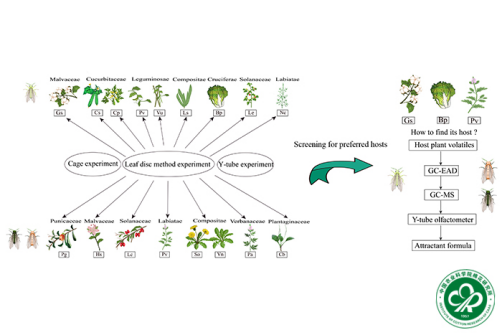- Location : Home» Newsroom
Identification of volatiles from preferred host plants of three winged morphs of Aphis gossypii and evaluation of luring-enhancing effects of volatile-based attractants
Recently, a research team led by Professor Cui Jinjie from the Cotton Research Institute of the Chinese Academy of Agricultural Sciences systematically elucidated the host plant selection preferences of cotton aphids on different winter/summer host plants. They identified the active substances that influence the host selection preference of cotton aphids. Based on these findings, the team developed a formula for attractants that enhance the efficacy of "sticky yellow boards" in attracting aphids. The related research was published in the renowned entomological journal Entomologia Generalis (IF=5.6, JCR Q1) under the title "Identification of volatiles from preferred host plants of three winged morphs of Aphis gossypii and evaluation of luring-enhancing effects of volatile-based attractants."
Three winged morphs (parthenogenetic winged female, PWF; gynopara; and male) of the cotton-melon aphid Aphis gossypii Glover (Hemiptera: Aphididae) facilitate the migration and host transfer of this pest. However, host plants preferred by these three winged morphs and their released volatiles remain largely unclear. Herein, the summer host plants (Gossypium hirsutum and Brassica pekinensis) preferred by PWFs and the winter host plant (Prunella vulgaris) preferred by gynoparae and males were screened from 17 tested host plants. In addition, active components that elicited the electrophysiological responses of the antennae of three winged morphs were identified. Y-tube olfactometer bioassays showed that active volatile compounds such as dibutyl phthalate, cis-3-hexen-1-ol and α-pinene were significant attractants for three winged morphs. The identified olfactory active volatile compounds (OAVCs) were formulated at different ratios into 18 attractant formulae, of which 4 formulae exhibited desirable luring-enhancing effect on PWFs, gynoparae, and males. Styrene, cis-3-hexen-1-ol, a-pinene, and others were dominant ingredients. These four effective formulae were expected to develop environmentally friendly pesticides to control pests by blocking the migration of winged cotton aphids. Taken together, our findings provide research models for the development of new plant-derived green aphid control technologies based on the interactions between cotton aphid and host plants.
This research was supported by the National Natural Science Foundation of China (No.32102214), the National Key R&D Program of China (2022YFD1400300), the Science and Technology Innovation Project of the Chinese Academy of Agricultural Sciences, and the Special Fund for Modern Agricultural Industry Technology System (CARS-15-21).
https://doi.org/10.1127/entomologia/2024/2697
